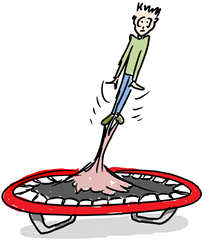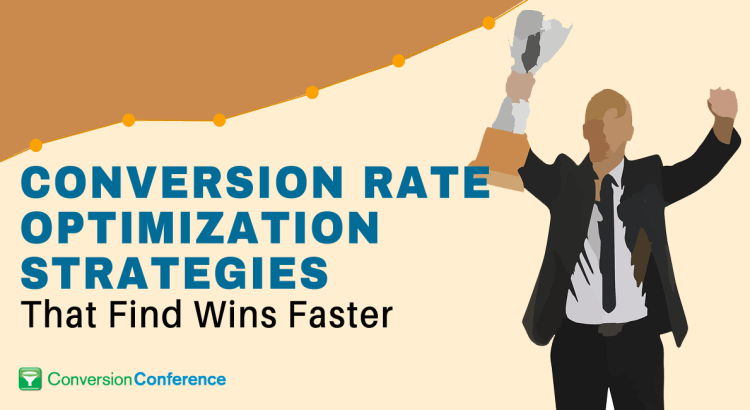We have used analysis and testing to find significant increases in revenue and leads for hundreds of companies. For each we fashion a unique strategy for what to test and where to start on the site.
However, there are several conversion optimization strategies that we consider when deciding how to find wins quickly and consistently. If you are beginning a conversion optimization process, this is your guide to testing strategies. For these seven strategies, I tell you
- When to use it.
- Where on the site to test.
- What to test.
- Pitfalls to be careful about.
For more on bounce rates, abandonment rates, conversion rates and more, see this post.
Gum Trampoline
We employ the gum trampoline approach when bounce rates are high, especially from new visitors. The bounce rate is the number of visitors who visit a site and leave after only a few seconds. Bouncers only see one page typically.
As the name implies, we want to slow the bouncing behavior, like putting gum on a trampoline.

When to Use It
You have a high bounce rate on your entry pages. This approach is especially important if your paid traffic (PPC or display ads) is not buying.
You have run out of paid traffic for a given set of keywords.
Where to Test
Most of your attention will be focused on landing pages. For lead generation, these may be dedicated landing pages. For ecommerce sites, these may be category pages or product pages.
What to Test
The key components of any landing page include:
- The offer that matches the ad, link or social post.
- The form that allows the visitor to take action. This may be just a button.
- The proof you use on the page that it’s a good decision.
- The trust you build, especially from third-party sources.
- The images you use to show the product or service. Always have relevant images.
Be Careful
Reducing bounce rate can increase leads and revenue. However, it can also increase the number of unqualified visitors entering the site or becoming prospects.
LT < (Less Than)
The Less Than or LT strategy begins testing at the call to action. For a lead-generation site, the LT strategy will begin with the action page or signup process. For an ecommerce site, we start with the checkout process.
Missed Conversion Conference Las Vegas 2016?
You can still catch up on the latest conversion-boosting strategies from CRO experts.
Watch All 40+ Sessions on Video!
When to Use It
The LT strategy is used for sites that have a high number of transactions and a high abandonment rate. The abandonment rate is the percentage of visitors who start a checkout or registration process, but don’t complete it. They abandon the process before they’re done.
Where to Test
This process starts at the end of the process, in the shopping cart or registration process.
What to Test
There are lots of things that could be impacting your abandonment rate.
- Do you need to build trust with credit logos, security logos, testimonials or proof points?
- Are you showing the cart contents on every step?
- Do you require the visitor to create an account to purchase?
- Do your visitors prefer aone-step checkout or a multi-step checkout?
- Have you addressed yourreturn policy?
- Are you asking for unnecessary information?
Once you have reduced the abandonment rates, you can begin testing further upstream, to get more visitors into your optimized purchase or signup process.
Be Careful
Testing in the cart can be very expensive. Any test treatments that underperform the control are costing you real leads and sales. Also, cart abandonment often has its roots further upstream. Pages on your site that make false promises or leave out key information may be causing your abandonment rates to rise.
For example, if you don’t talk about shipping fees before checkout, you may have lots of people staring the purchase process just to find out what your shipping fees are.
GT > (Greater Than)
The Greater Than or GT approach is essentially the opposite of the LT strategy. With this strategy, you’re trying to get more visitors into the purchase process before you start optimizing the checkout or registration process.
When to Use It
Use this test is for sites with fewer transactions. The goal is to increase visits to the cart or registration process before we start testing at the bottom of the funnel.
Where to Test
Testing starts on the home page and landing pages for lead-generating sites. For ecommerce sites category pages and product pages get intense scrutiny.
What to Test
With this strategy, we are most often trying to understand what is missing from the product or service presentation.
- What questions are going unanswered?
- What objections aren’t being addressed?
- What information isn’t presented that visitors need?
- Is the pricing wrong for the value presented?
We will test headlines, copy, images and calls to action when we begin the GT strategy.
Be Careful
Even though we aren’t optimizing the checkout or registration process, avoid testing clicks or engagement metrics. Always use purchases or leads generated as the primary metric in your tests. It’s too easy to get unqualified visitors to add something to cart only to see abandonment rates skyrocket.
“Minesweeper” Optimization Strategy

Some sites are like the Minesweeper game that has shipped with Windows operating systems for decades. In the game you hunt for open squares and avoid mines. The location of minds is hinted at by numbered squares.
In this game, you don’t know where to look until you start playing. But it’s not random. This is like an exploratory testing strategy.
When to Use It
This strategy is for sites that seem to be working against the visitor at every turn. We see this when visit lengths are low or people leave products in the cart at high rates. Use it when things are broken all over the site, then dive into one of the other strategies.
As testing progresses, we get clues about what is really keeping visitors from completing a transaction. The picture slowly resolves as we collect data from around the site.
Where to Test
This strategy starts on the pages where the data says the problems lie.
What to Test
By its nature, it is hard to generalize about this testing strategy. As an example, we may believe that people are having trouble finding the solution or product they are looking for. Issues related to findability, or “discoverability” may include navigation tests, site search fixes, and changes to categories or category names.
Be Careful
This is our least-often used strategy. It is too scattershot to be used frequently. We prefer the data to lead us down tunnels where we mine veins of gold.
However, this is the most common of optimization strategies used by inexperienced marketers. It is one of the reasons that conversion projects get abandoned. The random nature of this approach means that there will be many tests that don’t help much and fewer big wins.
Big Rocks

Almost every site has a primary issue. After analysis, you will see that there are questions about authority and credibility that go unanswered. You might find that issues with the layout are keeping many visitors from taking action.
Big Rocks add fundamental components to the site in an effort to give visitors what they are looking for.
When to Use It
This strategy is used for sites that have a long history of optimization and ample evidence that an important component is missing.
Where to Test
These tests are usually site-wide. They involve adding fundamental features to the site.
What to Test
Some examples of big rocks include:
- Ratings and Reviews for ecommerce sites
- Live Chat
- Product Demo Videos
- Faceted Site Search
- Recommendation Engines
- Progressive Forms
- Exit-intent Popovers
Be Careful
These tools are difficult to test. Once implemented, they cannot be easily removed from the site. Be sure you have evidence from your visitors that they want the rock. Don’t believe the claims of higher conversions made by the Big Rock company salespeople. Your audience is different.
Big Swings

A “Big Swing” is any test that changes more than one variable and often changes several. It’s called a big swing because it’s when we swing for the fences with a redesigned page.
When to Use It
Like the Big Rock strategy, this strategy is most often used on a site that has a mature conversion optimization program. When we begin to find the local maxima for a site, it gets harder to find winning hypotheses. If evidence suggests that a fundamental change is needed, we’ll take a big swing and completely redesign a page or set of pages based on what we’ve learned.
Sometimes we start with a Big Swing if we feel that the value proposition for a site is fundamentally broken.
Where to Test
We often take big swings on key entry pages such as the home page or landing pages. For ecommerce sites, you may want to try redesigning the product page template for your site.
What to Test
Big Swings are often related to layout and messaging. All at once, several things may change on a page:
- Copy
- Images
- Layout
- Design Style
- Calls to Action
Be Careful
Big swings don’t tell you much about your audience. When you change more than one thing, the changes can offset each other. Perhaps making the headline bigger increased the conversion rate on a page, but the new image decreased the conversion rate. When you change both, you may not see the change.
Nuclear Option
I’ll mention the nuclear option here, which is a site redesign. There are only two good reasons to redesign:
- You’re changing to a new backend platform.
- You’re redoing your company or product branding.
All other redesign efforts should be done with conversion optimization tests, like Wasp Barcode.
We even recommend creating a separate mobile site rather than using responsive web design.
Every website is different. The approach you take when testing a site should ultimately be determined by the data you have. Once you settle on a direction it can help you find bigger wins sooner.
This post first appeared on the Conversion Scientist Blog.
About the Author
 Brian Massey is the Conversion Scientist at Conversion Sciences and he has the lab coat to prove it. His rare combination of interests, experience and neuroses was developed over almost 20 years as a computer programmer, entrepreneur, corporate marketer, national speaker and writer.
Brian Massey is the Conversion Scientist at Conversion Sciences and he has the lab coat to prove it. His rare combination of interests, experience and neuroses was developed over almost 20 years as a computer programmer, entrepreneur, corporate marketer, national speaker and writer.
Brian is the author of Your Customer Creation Equation: Unexpected Website Formulas of The Conversion Scientist™

 717 798 3495
717 798 3495



